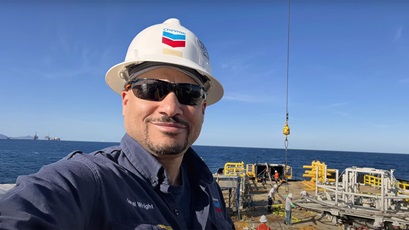our operations
explainer: what is a tieback?
3 min read | may 15, 2025
A subsea tieback connects offshore oil and gas fields to existing production facilities via pipelines and other infrastructure.
Isral Wright, a Chevron subsea hardware and installation engineer, explains how tiebacks work at Chevron's Ballymore Field.
Rick Kopps knows a lot about what lies beneath the surface of the Gulf of America—at least as far as oil and gas operations are concerned.
Kopps, Chevron’s chapter manager of subsea controls and power, has been working on subsea equipment for more than 30 years. He recently provided technical support to enable a successful tieback from Chevron’s Ballymore Field to the existing Blind Faith facility.
rick kopps
chapter manager of subsea controls and power
how tiebacks work
Subsea tiebacks connect offshore oil and gas fields to existing production facilities via pipelines. One way to think of a tieback is as a long garden hose running from a faucet to a garden—or, in this case, from a resource to a production facility.
To create a tieback, an oil and gas company drills wells on the seabed and then installs equipment that directs the hydrocarbon flow through a gathering system.
The hydrocarbons are transported, via flowlines, to a host platform, where minimal processing is done.
Tiebacks enable the extraction of oil and gas from remote or deep locations without the need for a new, stand-alone production platform.
benefits of tiebacks
Tiebacks allow Chevron to do more with less. They add shareholder value by lowering development costs while maximizing output.
And by linking existing production facilities to commercial reservoirs, they can also keep those facilities producing longer.
chevron’s position in the gulf of america
With a more than 85-year track record of success in the Gulf, Chevron is continuing to grow operations there.
Chevron’s goal is to produce
300,000 net barrels
of oil-equivalent per day in the Gulf of America in 2026.
Chevron is continuing to build its deepwater portfolio through exploration near existing assets. In the Gulf of America, a significant amount of Chevron’s portfolio is within tieback range. Last month, Chevron started oil production at Ballymore, which is just three miles away from the Blind Faith platform.
In addition to using a subsea tieback to an existing facility, the project leverages standardized equipment and repeatable engineering solutions. It is expected to produce up to 75,000 gross barrels of oil per day.
taking tiebacks further
Kopps shared how new technologies have enabled Chevron to connect tiebacks to platforms at greater distances. He said that subsea pumping technology, for example, extends tieback ranges from a few miles to 60 miles—all while improving recovery rates.
These extended ranges are allowing Chevron to tap into more fields without having to build new platforms to accommodate them.
rick kopps
chapter manager of subsea controls and power
topics covered
related content
-

 getting real about the energy future—in a world where 750 million people still lack electricity
getting real about the energy future—in a world where 750 million people still lack electricityour operationsmay 13, 2025
-

 building a stronger future powered by american energy
building a stronger future powered by american energyour operationsmay 05, 2025
-

 delivering first oil while lowering development costs
delivering first oil while lowering development costsour operationsapril 21, 2025
-

 decommissioned platform transforms into reef
decommissioned platform transforms into reefour operationsmarch 19, 2025
chevron email updates
Subscribe to our newsletter to receive news and updates.



